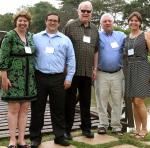SPRINGFIELD, Mo. – Keep it simple. Stay flexible. Cut costs. Milk producers heard those messages at the Dairy Grazing Conference at Springfield Expo Center, Oct. 23-25.
Conference speakers help define the evolving business of making milk from grass. Farmers, university academics and business leaders shared ideas with 190 people enrolled.
A new term was used, not heard at three previous biennial conferences: “Hybrid dairies.”
Two years of drought helped redefine how milk is made. High grain prices hit conventional dairy farms hard, forcing many to quit. Grazing dairies adopted the practice of feeding some grain to fill grazing gaps. Low-cost forages help graziers survive.
Tony Rickard, University of Missouri Extension dairy specialist, said: We made it too complicated with too many forage varieties in the beginning. The first New Zealand dairymen who started dairy farms in Missouri told us: “Just keep it simple.”
Now, U.S. graziers use fewer types of forage in their grazing paddocks. The recipe contains cool-season grasses and warm-season species. Over time, New Zealanders adapted more U.S. forages.
A New Zealand speaker said Missouri can have four seasons in one day. “In New Zealand we had winters of 30 degrees and summers in the 70s.”
Missouri specialists reported what they learned in creating systems with cows, grass and economics. Then they took visitors to see their dairy grazing research at MU Southwest Center at Mount Vernon, Mo.
In a welcome, Dave Baker, assistant dean for extension at the MU College of Agriculture, Food and Natural Resources, told visitors that Missouri is a forage state. “Grazing animals convert grass into farm profits.”
Beside Missourians, the conference drew international dairy people from Ireland and New Zealand, and U.S. dairy farmers from Florida, Michigan and Texas. Some came to check out starting dairy farms in the state.
Missouri retains an infrastructure supporting dairy business, from trucking to manufacturing to artificial insemination suppliers.
Visitors noted that the state has local data from the research dairy herd at the nearby Southwest Center. MU specialists help with planning and analysis of farm results.
Technical talks ranged from importance of first-day nutrition for calves, to matching calving to the grass-growing cycle and keeping the cow’s rumen, her first stomach, functioning.
Farmers added advice as well.
Eric Neill, Freeman, Mo., opened his talk with “Follow me around and do the opposite of what I do.” He told of his risk management methods. In his first attempt, he protected his milk price on the futures market. But he did not protect his feed prices. “Big mistake,” he said.
Craig Zydenbos, Sarcoxie, Mo., added a small irrigation system to keep his grass growing in the dry months.
Brian Peterson, Trenton, Mo., told how grazing dairy attracted two sons to return to the farm. He had converted the family farm from conventional dairy into a grazing dairy. “That improved the economics,” he added.
Grazing dairies can match their milking season to fit the grass-growing season. That allows shutting down milking for six weeks, which includes Christmas break. Conventional dairies milk 365 days a year, morning and night.
Grazing dairies reduce labor another way. There is less baling, storing and hauling of hay. Cows harvest most of their feed. That cuts machinery costs as well.
In conversations, dairy graziers in attendance noted that the new dairy farms are using some form of dairy-grazing system. The low-input farms allow young farmers to get a start.
Printed proceedings can be purchased for $25. Contact conference coordinator Ryan Milhollin, 573-882-0668. The proceedings can be viewed for free on the “Missouri Dairy Resources Guide” website at http://dairy.missouri.edu/
The papers will be uploaded a week after the conference.
Read more http://extension.missouri.edu/news/DisplayStory.aspx?N=2026





